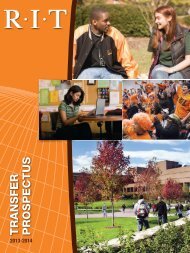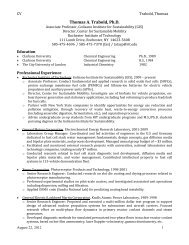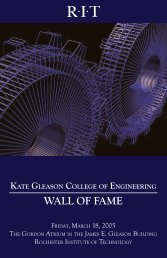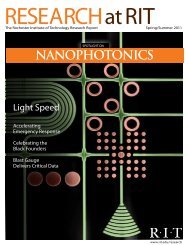Fall / Winter 2012 - Rochester Institute of Technology
Fall / Winter 2012 - Rochester Institute of Technology
Fall / Winter 2012 - Rochester Institute of Technology
You also want an ePaper? Increase the reach of your titles
YUMPU automatically turns print PDFs into web optimized ePapers that Google loves.
A Community <strong>of</strong> Scholars and<br />
Educators: Students, staff, and<br />
faculty at RIT come together<br />
to promote cutting-edge<br />
research and help create our<br />
next generation <strong>of</strong> scientists<br />
and engineers. Through a<br />
multitude <strong>of</strong> projects in<br />
numerous disciplines these<br />
teams are creating technologies<br />
and making discoveries<br />
that will improve society.<br />
College <strong>of</strong> Science. “The result has been the creation <strong>of</strong> an exciting<br />
and dynamic environment that is moving RIT toward being the<br />
first university synonymous with undergraduate research.”<br />
Embryo<br />
Sea Urchins Brittle Stars Sea Stars<br />
Discovering How Species Evolve<br />
Like the relationship between humans and<br />
apes, the Esmark serpent star and the spiny<br />
brittle star are genetically very similar animals.<br />
Both are brittle stars, similar to a starfish,<br />
are members <strong>of</strong> the echinoderm phylum, and<br />
Barbara Spieker<br />
evolved from the same common ancestor.<br />
However, we still know very little about how the species<br />
diverged from each other approximately 450 million years<br />
ago and the impact different genes had on that divergence.<br />
Barbara Spiecker was part <strong>of</strong> a team <strong>of</strong> scientists, led by<br />
Hyla Sweet, an associate pr<strong>of</strong>essor <strong>of</strong> biological sciences,<br />
that is attempting to solve this puzzle through the use<br />
<strong>of</strong> comparative gene expression and function.<br />
“By comparing how similar genes function differently in<br />
the two species we can learn more about how development<br />
Larva<br />
Adult<br />
Genes and Evolution: An RIT team is seeking to uncover how genetically<br />
similar species such as sea urchins, brittle stars, and sea stars evolved<br />
into the animals we now see today. By analyzing gene expressions the<br />
team hopes to shed new light on the impact central developmental<br />
genes have on species evolution.<br />
<strong>of</strong> serpent stars and spiny brittle stars evolved to lead to the<br />
animals we now have today,” says Spiecker, a 2011 biology<br />
graduate who spent four years working in Sweet’s lab.<br />
Primus, 2005<br />
Research at RIT<br />
21

















